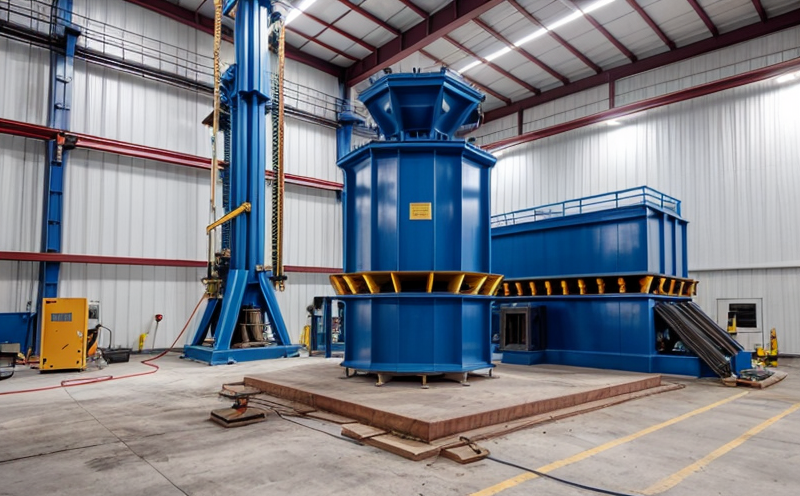ASTM E1876 Natural Frequency Testing of Building Materials
The ASTM E1876 standard provides a comprehensive framework to determine the natural frequency of building materials, which is crucial for understanding their dynamic behavior under various loading conditions. This test is particularly important in sectors such as construction and civil engineering where structures must withstand environmental stressors without failure.
Understanding natural frequencies helps in predicting potential resonant phenomena that could compromise structural integrity. For instance, if a building material has a natural frequency matching the frequency of an external vibration source (such as wind or traffic), it may resonate, leading to fatigue and eventual failure. ASTM E1876 ensures that materials are tested under controlled conditions to identify their inherent vibrational characteristics.
The testing procedure involves subjecting specimens to a range of frequencies using shakers or other suitable devices until the natural frequency is reached. The specimen's response, typically measured in terms of acceleration or displacement, provides insights into its dynamic properties. This data is then compared against industry standards and specifications to ensure compliance.
Specimen preparation for ASTM E1876 testing requires careful consideration of the material type and size. For instance, thin sheets may need support structures to prevent edge effects from influencing results. Proper clamping techniques are essential to avoid introducing external forces that could skew measurements. The test setup must also account for environmental factors such as temperature and humidity.
Instrumentation plays a critical role in ASTM E1876 testing, with accelerometers being the primary sensor used to capture vibrational data. Ensuring accurate calibration of these sensors is paramount to obtaining reliable results. Post-processing software then analyzes this raw data to calculate natural frequencies accurately.
The acceptance criteria for ASTM E1876 are strictly defined in accordance with international standards like ISO 9240 and EN 1343. Compliance ensures that the tested materials meet specified performance levels, thereby enhancing overall structural safety and durability. By adhering to these rigorous testing protocols, manufacturers can guarantee high-quality products that withstand real-world conditions effectively.
Real-world applications of ASTM E1876 include but are not limited to:
- Evaluating the durability of roofing materials against wind gusts
- Determining the resilience of floor coverings under foot traffic
- Assessing the impact resistance of glass panels in high-rise buildings
Why Choose This Test
Selecting ASTM E1876 natural frequency testing offers several advantages over alternative methods. Firstly, it provides precise and reliable data on material characteristics, which is invaluable for R&D purposes. Secondly, compliance with this standard enhances a company's reputation by demonstrating commitment to quality and safety standards.
For quality managers seeking assurance that their products meet regulatory requirements, ASTM E1876 offers peace of mind through its rigorous testing procedures. Compliance officers can rely on these results when preparing documentation for audits or certifications. Additionally, engineers responsible for designing new systems benefit from this information as it informs material selection and design iterations.
ASTM E1876 also supports procurement processes by providing objective criteria against which suppliers' products can be evaluated. This ensures that only materials meeting the highest standards are selected, thereby reducing the risk of substandard goods entering supply chains.
Quality and Reliability Assurance
Implementing ASTM E1876 natural frequency testing contributes significantly to both quality control and reliability assurance programs. By identifying potential issues early in the production process, companies can prevent costly rework or recalls downstream.
The test results serve as a benchmark for comparing different batches of materials or versions of products. This comparative analysis helps manufacturers fine-tune their processes continuously, ensuring consistent performance across all units produced.
In terms of reliability assurance, ASTM E1876 provides reassurance that the selected materials will perform consistently under expected usage conditions. This is particularly important for long-lived structures where initial design choices have lasting implications.
Customer Impact and Satisfaction
ASTM E1876 testing directly impacts customer satisfaction by delivering superior products that meet stringent performance expectations. When customers receive materials proven to be robust through rigorous testing, they gain confidence in the durability of their investments.
This confidence translates into higher levels of trust and loyalty among clients who appreciate transparent communication regarding product quality. Moreover, meeting such standards can open doors to new markets or partnerships based on shared values around excellence in craftsmanship and innovation.





